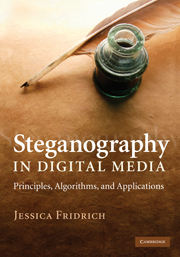Book contents
- Frontmatter
- Dedication
- Contents
- Preface
- Acknowledgments
- 1 Introduction
- 2 Digital image formats
- 3 Digital image acquisition
- 4 Steganographic channel
- 5 Naive steganography
- 6 Steganographic security
- 7 Practical steganographic methods
- 8 Matrix embedding
- 9 Non-shared selection channel
- 10 Steganalysis
- 11 Selected targeted attacks
- 12 Blind steganalysis
- 13 Steganographic capacity
- A Statistics
- B Information theory
- C Linear codes
- D Signal detection and estimation
- E Support vector machines
- Notation and symbols
- Glossary
- References
- Index
- Plate section
3 - Digital image acquisition
Published online by Cambridge University Press: 05 April 2014
- Frontmatter
- Dedication
- Contents
- Preface
- Acknowledgments
- 1 Introduction
- 2 Digital image formats
- 3 Digital image acquisition
- 4 Steganographic channel
- 5 Naive steganography
- 6 Steganographic security
- 7 Practical steganographic methods
- 8 Matrix embedding
- 9 Non-shared selection channel
- 10 Steganalysis
- 11 Selected targeted attacks
- 12 Blind steganalysis
- 13 Steganographic capacity
- A Statistics
- B Information theory
- C Linear codes
- D Signal detection and estimation
- E Support vector machines
- Notation and symbols
- Glossary
- References
- Index
- Plate section
Summary
This book focuses on steganographic methods that embed messages in digital images by slightly modifying them. In this chapter, we explain the process by which digital images are created. This knowledge will help us design more secure steganography methods as well as build more sensitive detection schemes (steganalysis).
Fundamentally, there exist two mechanisms through which digital images can be created. They can be synthesized on a computer or acquired through a sensor. Computer-generated images, such as charts, line drawings, diagrams, and other simple graphics generated using drawing tools, could, in principle, be made to hold a small amount of secret data by the selection of colors, object types (line type, fonts), their positions or dimensions, etc. Realistic-looking computer graphics generated from three-dimensional models (or measurements) using specialized methods, such as ray-tracing or radiosity, are typically not very friendly for steganography as they are generated by deterministic algorithms using well-defined rules. In this book, we will mostly deal with images acquired with cameras or scanners because they are far more ubiquitous than computer-generated images and provide a friendlier environment for steganography. As with any categorization, the boundary between the two image types (real versus computer-generated) is blurry. For example, it is not immediately clear how one should classify a digital-camera image processed in Photoshop to make it look like Claude Monet's style of painting or a collage of computer-generated and real images.
- Type
- Chapter
- Information
- Steganography in Digital MediaPrinciples, Algorithms, and Applications, pp. 33 - 46Publisher: Cambridge University PressPrint publication year: 2009



